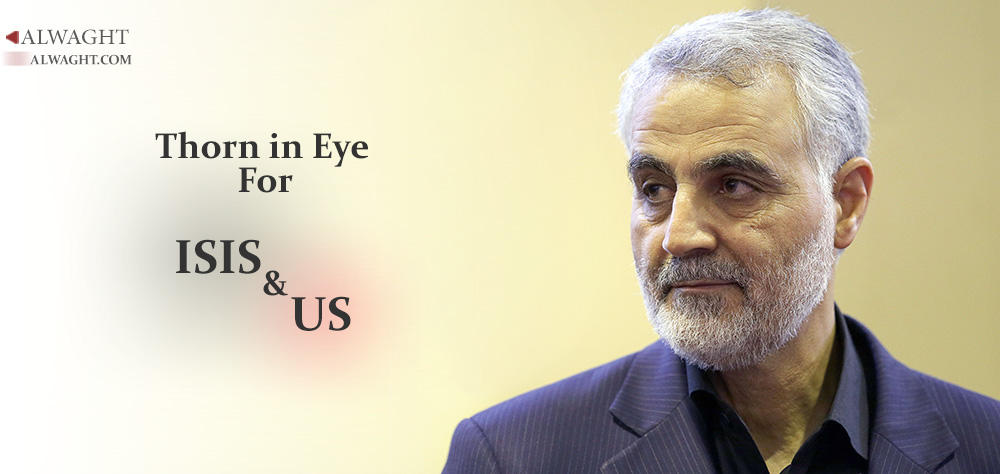Alwaght- His name first shined in battles of Iraq’s Jurf Al Sakhar and Amirli, then in Ramadi. Afterwards, he moved to Syria's Idlib as well as Aleppo. And today he is highly needed for his arrangements and tactics for the decisive Fallujah battle. He is the man of facing the takfiri groups and their backers, and the safe haven when the battle warms up. He is the chief of Iran’s Quds Force General Qasem Soleimani.
A lot of evidences could be found on this 50-year-old man who led the Iranian Sarallah 41 Brigade during Saddam Hussein’s war against Iran in the 1980s.
Despite the fact that General Soleimani’s name is on the US terror blacklist, the US Secretary of State John Kerry has asked for a meeting with him who is not much carrying about media appearance and promotion. He believes that confronting the US is part of confrontation of the ISIS terror organization against which he has moved after receiving orders from Iran’s Leader of the Islamic Revolution Ayatollah Sayyed Ali Khamenei.
Although he does not appear on the media nor does he take part much in the official meetings, he has dominated the headlines of both the Arab and global media.
The Newsweek magazine has put General Soleimani's image on its cover with a caption which read: “nemesis. First he fought America. Now he is crushing ISIS."
Far from the Western media, the General is now the leader of mind of the Arab and Muslim youths who see him a man desperately missing in their own countries.
A commander of the Islamic Revolutionary Guards Corps (IRGC), General Soleimani has taken a variety of posts starting from being commander of Sarallah 41 Brigade in the country's Kerman province— his birthplace — during the Iraqi-Iranian war, then he moved to be the chief of border guards in the eastern provinces where drugs smugglers are active as the provinces share borders with Pakistan and Afghanistan, and as Taliban group has been active next to Iran’s borders before and during the US invasion of Afghanistan.
He then became the chief of IRGC's Quds Force, and he made it a power seriously intimidating all of Iran’s enemies.
General Soleimani was not unlinked to the blows dealt to the American forces by the Iraqi resistance forces during the occupation of Iraq.
Haj Qasem, as he is known by IRGC, was the first man to be beside the Iraqi forces, the Arab and Kurdish forces and the Sunni and Shiite forces to save the Iraqi capital Baghdad from a scenario similar to that of Mosul which within hours fell to ISIS terrorists.
As the Iraqis admit, without Iran’s support and presence of General Soleimani in Iraq the government of Prime Minister Haider al-Abadi was now outside Iraq.
The General is known for his calm and good vision and strong administration which make him present everywhere in anti-terror camps, without any lapses. He protected Baghdad and attended the battlefields of Syria's Damascus. He, then, moved to the frontlines of Aleppo and Idlib where the terrorist and takfiri groups are holding ground. He is granted a title: “the strongest security official of the Middle East."
Despite his little appearance in public, his grandeur of presence is firmly established for both his enemies and friends— an issue pushed the US to accuse him of intervention in Iraq and destabilizing the security there.
General Soleimani as a pattern
Why should the US fear General Soleimani while he is considered as the strongest man in the face of ISIS terrorism against which the US claims has launched its campaign? This is a question that is necessary to answer; not only simply necessary but also desperately needed. The answer perhaps is an answer to many questions about Iran’s activities in the region.
Through the battles he led, General Soleimani has presented a new and, at the same time, strong pattern dissimilar to the US double standards in dealing with the issue of terrorism, not to mention his presence in the frontlines of anti-terror fight, authenticating the Islamic Republic's honesty and resolve in fighting the terrorists.
The General's discourse is different from that of the US. While Washington even targets the anti-terror fighters who are engaged in fighting against ISIS, the Quds Force's general tells the anti-ISIS forces "move ahead and I'm ahead of you."
"There is a great difference between telling the fighters go and telling them come," this was a point General Soleimani recently made it clear during a speech.
Perhaps the most blatant feature of General Soleimani's thought is his enmity to the US as he identifies Washington as standing behind all of the crises in the region from the imposed war of Saddam Hussein against Iran to rise of ISIS terrorist organization in the region.
The General never ceases thinking and working to foil the US projects in the region. He seeks calling attention of everyone to the dangers of US plans for the region even if when he is fighting in the frontlines against ISIS.
General Soleimani proved successful in presenting a firm pattern as a replacement for that of the US, going deep in the minds of the Arab and Muslim nations against the will of many of the regional and international governments. This is the major reason behind launching tarnishing campaigns against the anti-ISIS Iranian military commander whether during Fallujah battle or before it and perhaps after it.
The General's pattern is not confined to the Muslim and Arab worlds. Even in the West he has gained fame as many writers call him the leader of world's proxy war against the ISIS terror group.
The US is afraid of General Soleimani who has thwarted its projects in the region. Perhaps this is what meant by Imam Khomeini, the founder of the Islamic Republic, who said “we export our revolution to the whole world so that everybody figures out why we revolted."



























